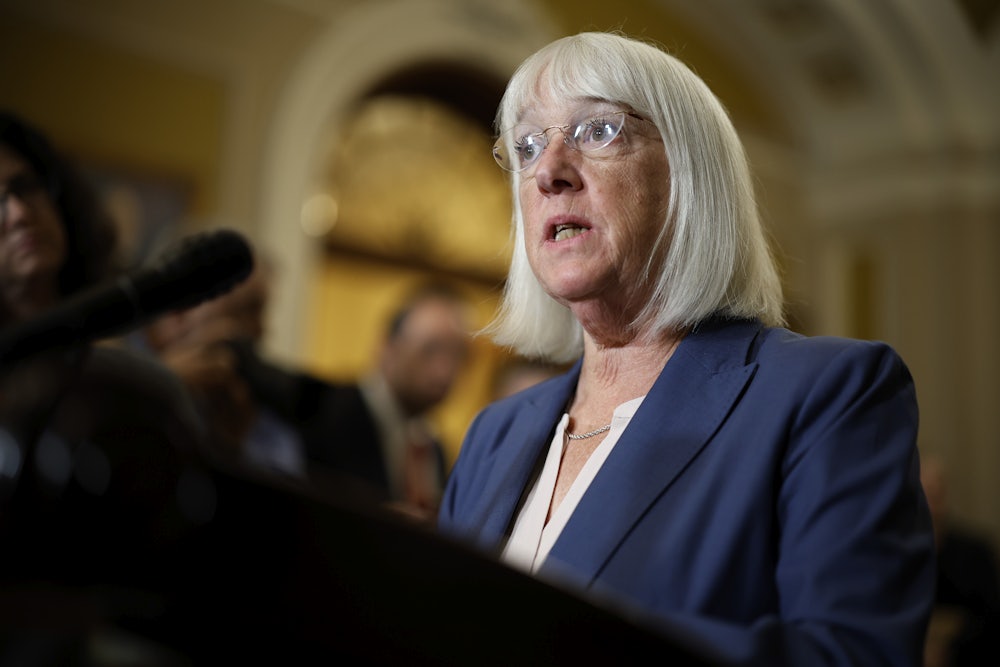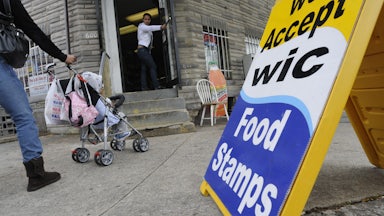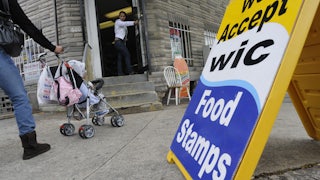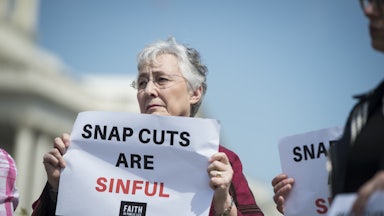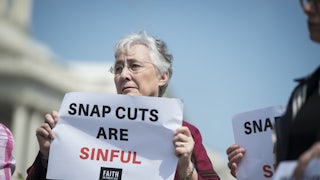The Biden administration has warned that a key nutrition assistance program will face a significant funding shortfall this year, potentially preventing millions of low-income women and children from receiving necessary benefits. Unless Congress provides an additional $1 billion, participants in the Special Supplemental Nutrition Program for Women, Infants and Children, also known as WIC, may be pushed onto waiting lists, or could lose their benefits altogether.
On Thursday, Congress passed a stopgap funding measure to keep the government funded through March; however, it did not include additional funding for WIC. It’s still unclear whether Congress will be able to finalize the appropriations bill for the U.S. Department of Agriculture before the new deadline of March 1—or whether that measure will include the $1 billion needed to make up for WIC’s funding shortfall.
Senator Patty Murray, the chair of the Senate Appropriations Committee, indicated that keeping WIC funded would be a priority as lawmakers continue to finalize spending bills in the coming weeks. “As I’ve said repeatedly: Failing to fully fund WIC for the first time ever is not acceptable to me—and as we continue working to negotiate and pass full-year spending bills, I am fighting to ensure WIC has the resources it needs to keep serving eligible families and help kids thrive, just as it has for decades,” Murray said in a statement.
The program, which is celebrating its fiftieth anniversary this year, has historically been a bipartisan priority. Because it is not an entitlement program, WIC needs to be funded annually. Congress has passed sufficient WIC funding on a bipartisan basis every year since 1997, meaning that the current struggle over the program is unprecedented in the twenty-first century.
“For the first time in this millennium, WIC is in danger of having to turn families away from the program,” said Nell Menefee-Libey, the senior public policy manager at the National WIC Association. “Congress kicking the can down the road twice now means that there would be a much smaller portion of the fiscal year left to make up a funding shortfall.”
The previous short-term government funding measures passed in the fall of last year granted USDA additional flexibilities to ensure WIC remained fully funded; this came after USDA told Congress that more funding was needed. As the agency and states are spending money at a faster rate to keep the program afloat through March, USDA has warned the shocks will be even greater at the end of the fiscal year when those resources are expended. The $1 billion shortfall would be equivalent to around a month and a half of benefits for all WIC recipients, and six months of benefits for all pregnant women and infants.
Without the funds to keep up with current demand, many states will likely implement waiting lists. The move would have a staggered impact on different populations of recipients: It will initially affect postpartum mothers who are not breastfeeding, followed by children ages 1 through 5 who don’t have serious health issues, and finally pregnant and breastfeeding women and their infants. But even these cost-reduction measures may not be enough to close the funding gap; certain participants could see their benefits suspended or even discontinued. The Center for Budget and Policy Priorities, a left-leaning policy research organization, estimates that roughly two million eligible parents and children could be turned away from the program by September if the current funding levels for WIC are not extended.
The seeming lack of bipartisan urgency on keeping WIC fully funded could be attributed in part to larger struggles over government funding. Many hard-line conservative Republicans in the House have complained that the continuing resolutions keeping the government funded have not made more dramatic cuts to non-defense programs. Additional funding for WIC has now also been entwined in the public consciousness with pandemic relief spending, said Kelly Horton, the chief program officer at the Food Research and Action Center. As coronavirus relief measures approved by Congress included flexibilities to streamline WIC enrollment and an increase in cash voucher amounts, politicians may associate new funds for WIC with continuing emergency pandemic funding—a particularly unpopular prospect on the right, which believes there should be a return to pre-pandemic spending.
“The vital nutrients that are provided with WIC, particularly through the fruits and veggie voucher program, they’re really essential, and they make the program palatable and of interest to moms and their kids,” said Horton. “Unfortunately, that’s gotten caught up in the … rollback of everything that was happening during the pandemic. And I think folks have lost sight of the fact that we’re talking about hunger with moms and kids.”
WIC is a critical program for the nation’s low-income mothers and young children; in 2022, nearly 40 percent of all infants in the United States received WIC benefits. Research has found that maternal WIC participation is associated with a lower risk of preterm delivery and infant mortality, increased preventive care and better cognitive development for children, and purchasing of healthier foods for mothers and children. The program helps participants buy certain food items, and provides vouchers for pregnant, postpartum, and breastfeeding parents to purchase fruits and vegetables. It also offers breastfeeding support and health care screenings and referrals.
Emily Church, a mother living in Millfield, Ohio, has relied on WIC in the infancy and early childhood of both of her children: her son Kayson, now 19, and her 3-year-old daughter, Myles Mae. “The package includes $26 in cash [vouchers], fruits and vegetables, eggs, milk, cheese, and peanut butter—I often say, it’s close to probably at least an $80 value, if not more, when all is said and done,” Church said.
But Church, who is employed at a local creamery and is currently working on her bachelor’s degree, relies on WIC for more than financial assistance. It provides resources such as recipes and health and wellness tips, and tracks her daughter’s milestones. When her son was born, WIC specialists taught her how to breastfeed.
As she is no longer breastfeeding, Church worries that her family would be “first on the chopping block” if WIC is not fully funded. “It makes me feel fearful. It makes me feel angry,” Church said. “I’m already working and doing everything I can to make ends meet, and trying to better myself along the way. And you know, that’s a lot for my budget to be gone.”
Despite its importance, WIC is often underutilized by the population that needs it most. A recent report by USDA found that WIC served just over 51 percent of those eligible in 2021. (However, preliminary data shows an increase in WIC participation in 2023.) There are already some challenges to participating in WIC, including the inability to buy WIC-approved items online, although some states have launched pilot programs to allow for electronic purchase. There are also stringent requirements for stores to participate in WIC, including some larger stores, which may not carry WIC-approved brands or meet program criteria.
Moreover, nine states—including Ohio—are “offline” states, meaning that participants must physically visit a WIC office to load their benefits onto their cards. (Those states also tend to have a lower participation rate compared to the national average.)
There are efforts in Congress to improve access to WIC, including bipartisan legislation that would allow participants to certify their eligibility for the program online. Representative Brian Fitzpatrick, the bill’s Republican lead co-sponsor in the House, said that he hoped the bill could be attached to a larger legislative vehicle in the future. “It’s the right thing to do, but also it makes sense from an economic standpoint as well, because it’s the most efficient way to take care of this problem,” Fitzpatrick said about the efficacy of WIC in serving low-income families.
However, while advocates outside of Congress would like to expand and streamline WIC to make it easier to access, keeping the program afloat is the first priority. “As long as the house is on fire, we can’t really think about renovating,” Menefee-Libey said.
The states that have the highest participation rates could run out of resources more quickly. In North Carolina, for example, where more than 60 percent of those eligible participated in WIC in 2021, state Health and Human Services Secretary Kody H. Kinsley said, “federal funding has already forced us to implement cost-saving measures to manage the WIC program under continuing resolutions.”
“If funding for this program continues to be starved, implementation of additional cost-savings measures may be necessary, including the possibility of a waitlist for some participants or making immediate program cuts,” Kinsley said in a statement. “WIC services are critical for ensuring a healthy start for North Carolina children, and not fully funding it would have long-term fiscal impacts to the program and long-term consequences for families and children that will not be able to access healthy food.”
Horton also noted that many WIC agencies were still understaffed in the wake of the pandemic, which has contributed to an increased waiting time for applications to be processed. “We’ve heard of various states where people are waiting for hours on the telephone line to get an appointment to get in to get their benefits,” said Horton.
Lack of funding could also contribute to lower rates of participation in the WIC: If mothers knew they could be placed on a waiting list, it may further discourage eligible people from enrolling. However, while the threat of being pushed onto a waiting list may discourage some enrollment, it could also push many families into relying ever more on food banks while they wait to obtain benefits.
“We think when somebody is trying to feed their family, they’re going to do everything they can. So they may get on the waitlist, and then they’re going to do what they can to get their family food, and it’s just going to be more frustrating for them,” Horton continued.
Church, the WIC participant in Ohio, speaks publicly about what the program means to her family because she wants lawmakers to understand its importance—and encourage them to take the impending shortfall seriously. “I would just implore them to look at why WIC exists, and the impact that it makes in so many people’s lives,” she said.
